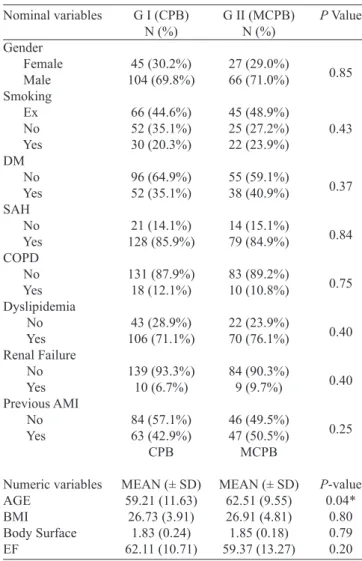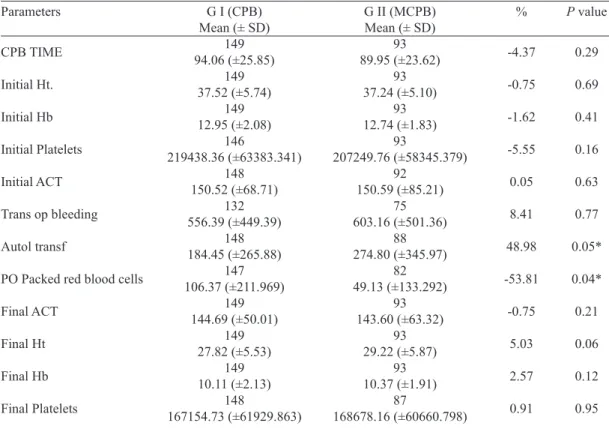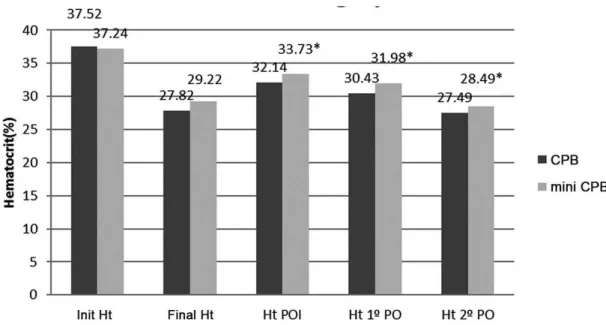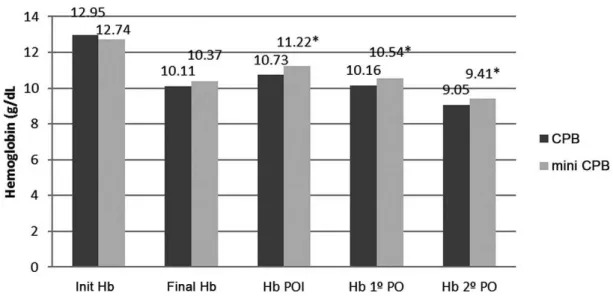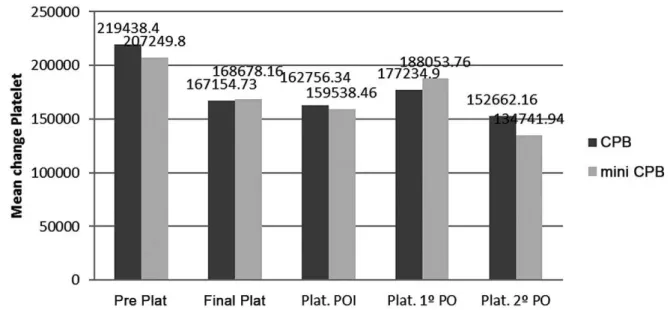RBCCV 44205-1661 DOI: 10.5935/1678-9741.20150046
Comparison of two technics of cardiopulmonary
bypass (conventional and mini CPB) in the trans- and
postoperative periods of cardiac surgery
Comparação de duas técnicas de circulação extracorpórea (convencional e mini CEC), nos períodos trans
e pós-operatório de cirurgia cardíaca
Sergio Nunes Pereira
1, MD, PhD; Izabelle Balta Zumba
2; Micheline Sulzbacher Batista
2; Daniela
Da Pieve
2; Elisandra dos Santos
2, MSc, PhD; Ralf Stuermer
3, MD; Gerson Pereira de Oliveira
3,
MD; Roberta Senger
31Centro de Ciências da Saúde da Universidade Federal de Santa Maria (CCS – UFSM), Santa Maria, RS, Brazil.
2Universidade Federal de Santa Maria (UFSM), Santa Maria, RS, Brazil. 3Hospital Universitário de Santa Maria (HUSM), Santa Maria, RS, Brazil.
This study was carried out at Universidade Federal de Santa Maria (UFSM), Santa Maria, RS, Brazil, and Hospital Universitário de Santa Maria (HUSM), Santa Maria, RS, Brazil.
Financial Support: Hospital Universitário de Santa Maria.
Correspondence address: Sergio Nunes Pereira
Universidade Federal de Santa Maria
Av. Roraima, 1000 – Camobi - Santa Maria, RS, Brazil Zip code: 97105-900
E-mail: sergio.nunespereira@gmail.com
Article received on February 17th, 2015 Article accepted on June 23rd, 2015 Abstract
Objective: This study aimed to compare the effects of two different perfusion techniques: conventional cardiopulmonary bypass and miniature cardiopulmonary bypass in patients un-dergoing cardiac surgery at the University Hospital of Santa Maria - RS.
Methods: We perform a retrospective, cross-sectional study, based on data collected from the patients operated between 2010 and 2013. We analyzed the records of 242 patients divided into two groups: Group I: 149 patients undergoing cardiopul-monary bypass and Group II - 93 patients undergoing the min-iature cardiopulmonary bypass.
Results: The clinical proile of patients in the preoperative
period was similar in the cardiopulmonary bypass and
min-iature cardiopulmonary bypass groups without signiicant
differences, except in age, which was greater in the miniature cardiopulmonary bypass group. The perioperative data were
signiicant of blood collected for autotransfusion, which were
higher in the group with miniature cardiopulmonary bypass than the cardiopulmonary bypass and in transfusion of packed red blood cells, which was higher in cardiopulmonary bypass than in miniature cardiopulmonary bypass. In the immediate,
irst and second postoperative period the values of hematocrit
and hemoglobin were higher and signiicant in miniature car
-diopulmonary bypass than in the car-diopulmonary bypass,
al-though the bleeding in the irst and second postoperative days was higher and signiicant in miniature cardiopulmonary by -pass than in the cardiopulmonary by-pass.
Conclusion: The present results suggest that the
minia-ture cardiopulmonary bypass was beneicial in reducing the
red blood cell transfusion during surgery and showed slight
but signiicant increase in hematocrit and hemoglobin in the
postoperative period.
INTRODUCTION
Cardiac surgery had major limitations in the beginning, in the early twentieth century, for not being able to stop and open the heart to treat intracardiac lesions. However,
from the development of an artiicial heart-lung machine[1],
showed great progress, especially with the development of cardiopulmonary bypass, progressively improved until 1954, when its use in humans has started[2]. Since that time this
technique has become widespread worldwide and known as the largest contribution to cardiac surgery and cardiology for the world[3-5]. In Brazil this technique started in 1955[6-7],
fol-lowed by several surgeons[8-12], which put the country in an
international leading position in cardiovascular surgery with important contributions to the development and improve-ment of perfusion. However, with the method came the chal-lenges to circulate blood into metal and plastic surfaces. The contact of blood with this surfaces predisposes to changes in blood components, such as red cells, white cells, plate-lets, and plasma lipoproteins, that can suffer degradation and partial destruction of these elements, resulting in anemia and
tissue inlammatory reactions as the systemic inlammatory
response syndrome (SIRS)[13], need for transfusion with
ho-mologous red blood cells[14] and increased risk of
postopera-tive infection[15]. Because of this situation, various techniques
were used, such as coronary artery bypass grafting without cardiopulmonary bypass (CPB) in 1955[16], and later with
Abbreviations, acronyms & symbols
1st POP First postoperative day
2nd POP Second postoperative day
ACT Activated coagulation time CABG Coronary artery bypass grafting CPB Cardiopulmonary bypass IOPP Immediate postoperative period MCPB Miniature cardiopulmonary bypass
SIRS Systemic inlammatory response syndrome
other surgeons[17-20], with good results in relation to the CPB.
But these technical limitations were reported as dificult as
revascularization of the lower wall of the left ventricle, large cardiomegaly and severe heart failure. In these situations, the technique often resulted in incomplete revascularization[21].
Another option found to the problems of CPB was to min-imize the volume of the infusion, with the miniaturization of the cardiopulmonary bypass (MCPB). Afterwards, several studies published comparing the CPB with off pump surgery
and the MCPB, inding lower presence of hemodilution, co -agulopathy[21] need for transfusion of red blood cells[22-27] and
lower systemic inlammatory reaction in the surgery without
CPB and MCPB in relation to the CPB[28]. It was also
ob-served higher hemoglobin levels in MCPB than in CPB[26].
When comparing off-pump surgery and MCPB, the
follow-ing effects were described: similar level of inlammatory re -sponse[25], but more controlled surgical ield[21], better
coro-nary artery bypass grafting (CABG)[25] and higher level of
hemoglobin in the MCPB than in off-pump. Other authors
considered not signiicant the difference between CPB and
the MCPB for bleeding, renal injury, length of stay[29] and
evolution of low-risk patients[30]. In our Service, at the
Uni-versity Hospital of Santa Maria, from 2010, we began using MCPB in CABG surgery. In 2011, we added to this technique an autotransfusion equipment with hemoconcentration. This year, a resident of anesthesia and Master’s student, compar-ing patients undergocompar-ing coronary artery bypass surgery found
Resumo
Objetivo: Este estudo teve como objetivo comparar os efeitos de duas técnicas de perfusão diferentes: convencional (CEC) e mini (MCEC) em pacientes submetidos à cirurgia cardíaca no Hospital Universitário de Santa Maria - RS.
Métodos: Foi realizado um estudo retrospectivo, transver-sal, baseado em dados coletados dos pacientes operados entre 2010 e 2013. Foram analisados os registros de 242 pacientes di-vididos em dois grupos: Grupo I - 149 pacientes submetidos à circulação extracorpórea e Grupo II - 93 pacientes submetidos à minicirculação extracorpórea.
Resultados: O peril clínico dos pacientes no pré-operatório
foi semelhante nos grupos circulação extracorpórea e
minicir-culação extracorpórea sem diferenças signiicativas, exceto na
idade, maior no grupo minicirculação extracorpórea. Os dados
perioperatórios foram signiicativos de sangue coletadas para
autotransfusão, que foram maiores no grupo com minicircu-lação extracorpórea do que a circuminicircu-lação extracorpórea e na transfusão de concentrado de hemácias, superior em circulação extracorpórea do que em minicirculação extracorpórea. Nos va-lores pós-operatório imediato, primeiro e segundo, os níveis de
hematócrito e da hemoglobina foram maiores e signiicativos na
minicirculação extracorpórea que no circulação extracorpórea, embora o sangramento no primeiro e segundo dias
pós-operató-rios tenha sido maior e signiicativo no minicirculação extracor -pórea que no circulação extracor-pórea.
Conclusão: Os resultados sugerem que a minicirculação
extra-corpórea foi benéica em reduzir a transfusão de células vermelhas do sangue durante a cirurgia e houve discreta, mas signiicativa,
elevação do hematócrito e hemoglobina no pós-operatório.
less need and lower volume of packed red blood cells in the autotransfusion group than in those without its use[28]. Based
on this initial experience, we decided to perform a retrospec-tive analysis with a review of medical records of patients un-dergoing consecutive cardiac surgeries in 2010 to 2013 pe-riod, regarding the effects of two types of cardiopulmonary bypass: (with conventional CPB and MCPB) on the results of clinical and laboratory parameters of the periods before, during and after surgery. Considering the fact that this study was retrospective, we analyzed mainly the clinical aspects and changes in the hemoglobin, hematocrit, platelets, com-plications related to bleeding and the need of red blood pack transfusion during surgery and in the postoperative period.
METHODS
Ethical considerations
This study was reviewed and approved by the Research Ethics Committee of the Federal University of Santa Maria, RS, with number CAAE: 21598213.1.0000.5346 and order number: 434.030. Date: 08/10/2013.
Data were collected in chips (Chart 1), whose items refer to clinical, surgical and laboratory parameters of the pre-, in-tra- and postoperative surgery, with emphasis on hematolog-ical aspects, bleeding and transfusions, regarding the patients underwent conventional CPB and MCPB. The preoperative data refer to clinical and laboratory parameters collected be-fore surgery; the perioperative are related to the period from the beginning to the end of surgery. The postoperative period was subdivided into three sub-periods: the early
postopera-tive period (POI) between arrival at the Intensive Cardiology
Unit (ICU) and 6:00 pm the following day, and then the irst
postoperative day (24 h after) and the second PO (48 h after). In this study we analyzed the medical records of 242 pa-tients who underwent surgery between 2010-2013, divided into two groups:
Group I (GI) - 149 patients undergoing surgery with con-ventional cardiopulmonary bypass (CPB).
Group II (GII) - 93 patients who underwent surgery with miniaturized cardiopulmonary bypass (MCPB).
The patients in GI underwent surgery with machine and conventional CPB circuits (Braile Biomédica®) and
cen-trifugal pump (Maquet®). The GII, were operated circuit,
centrifugal pump and MCPB Maquet® machine (Figure 1).
Auto transfusion was performed by using a device named Autolog (Medtronic®) (Figure 2), when deemed necessary
by the surgeon. The surgical procedures were performed by the usual techniques, corresponding to each system. Auto-log® was used in both types of perfusion: 148 in the CPB group and 88 in the MCPB group. Data were tabulated in spreadsheet (Excel 2010 Windows®), and analyzed using
the statistical package (SPSS 15.0)®, with test application
T Student for parameters with normal distribution and Mann Whitney test for abnormal distribution, considering
the signiicance of P<0.05. Inclusion criteria were cardiac surgeries performed sequentially in the period 2010-2013, and the exclusion were emergency surgery, reoperation and complex surgeries such as aneurysms and aortic dissection, given that our initial aim was to compare these perfusion techniques in routine surgery.
Chart I. Cardiac surgery sheet data of pre-, trans- and postoperative periods.
Hospital Records SAH
LITA
PRBC_Top
IP Plat.
Name
COPD
B. S.
B. B.
1st and 2nd POP Bleed.
Age
Dislipidemia
C.T.
End ACT
1st and 2nd POP Ht
Sex
Renal Insuff.
Time ECC
End Ht
1st and 2nd POP Hb
BMI=body mass index; BS=body surface; DM 2= diabetes mellitus type 2; SAH=Hypertension; COPD=chronic obstructive pulmonary disease; Dyslipid=dyslipidemia; Renal F=renal failure; AMI=acute myocardial infarction; EF=ejection fraction; LITA=left internal thoracic artery; CABG=coronary artery bypass surgery; Clamp T=clamp time; Init Ht=initial hematocrit; Init Hb= initial haemoglobin; Pre Plat=previous platelets; Init ACT=activated clotting time; IP Bleed=intraoperative bleeding; Autol Tr=autologous transfusion; CRBC=concentrate of red blood cells; Blood Bal=blood balance; ACT: activated clotting time; Final Ht=inal Hematocrit; Final Hb=inal hemoglobin; Final Plat=inal platelets; IPO bleed.=Bleeding pf immediate postoperative bleeding; IPO Ht=immediate postoperative hematocrit; IPO Hb=immediate postoperative hemoglobin; IPO CRBC= immediately postoperative CRBC; IPO Plat=Immediate postoperative period platelets; Bleed 1st
and 2nd PO=Bleeding on the 1st and 2nd postoperative day; Ht 1st and 2nd PO=hematocrit on the 1st and 2nd postoperative day; Hb 1st and 2nd
PO=hemoglobin on the 1st and 2nd postoperative day; Plat 1st and 2nd PO=Platelets on the 1st and 2nd postoperative day
Weight
Previous AMI
End Ht
End Hb
1st and 2nd POP Plat.
BMI
Other
Pre Plat.
IP Bleed.
Hosp. Dis.
Body Surface
Cir. Date
Initial ACT
IP Ht
Obs: Complication Smoking
Type of Surgery
Top Bleeding
IP Hb
DM_2
Type ECC
Autol. Transf.
RESULTS
The results were tabulated according to the analysis period: preoperative (Table 1), intraoperative (Table 2) and
postopera-tive (Table 3). The clinical proile of patients preoperapostopera-tively (Ta -ble 1) was similar in groups I (CPB) and II (mini CPB), differing only in age, the greater the mini CPB in relation to the CPB. (P<0.05). During the surgery (Table 2) there was no signiicant difference in duration of CPB and laboratory parameters and
bleeding. There were signiicant differences in the collection of
red blood cells for autologous transfusion (P<0.05) in the mini CPB in relation to the CPB and the volume of transfused red
blood cells concentrate (Figure 3) was greater and signiicant in
the CPB regarding the mini pump group (P<0.04).
The immediate postoperative period (Table 3), with discrete higher values of hematocrit and hemoglobin in the mini CPB
than in CPB (Figures 4 and 5), respectively, with signiicant dif -ferences (P<0.05). In the irst and second postoperative period
bleeding was also observed (Figure 6) and most signiicant in
the mini CPB in relation to the CPB (P<0.05), however, despite this, the hematocrit and hemoglobin levels remained higher in mini CPB than in the CPB, with subtle differences, but signif-icant (P<0.05). The complication about SIRS where referred in the Introduction, in the historic context of one important event that is related to CPB. However, in this study, we referred only the complications related to bleeding, need of RBC transfusion and change of erythrocytes, hematocrit, hemoglobin and platelets during surgery and postoperative period (Figure 7).
Fig. 1 - Maquet set consisting of mini bypass circuit connected to the centrifugal pump and the extracorporeal circulation machine.
Fig. 2 - Bypass set with centrifugal pump coupled with the module of auto transfusion (Autolog).
Table 1. Preoperative clinical and anthropometric parameters in CPB and MCPB groups.
Nominal variables Gender Female Male Smoking Ex No Yes DM No Yes SAH No Yes COPD No Yes Dyslipidemia No Yes Renal Failure No Yes Previous AMI No Yes Numeric variables AGE BMI Body Surface EF
G I (CPB) N (%) 45 (30.2%) 104 (69.8%) 66 (44.6%) 52 (35.1%) 30 (20.3%) 96 (64.9%) 52 (35.1%) 21 (14.1%) 128 (85.9%) 131 (87.9%) 18 (12.1%) 43 (28.9%) 106 (71.1%) 139 (93.3%) 10 (6.7%) 84 (57.1%) 63 (42.9%) CPB
MEAN (± SD) 59.21 (11.63)
26.73 (3.91) 1.83 (0.24) 62.11 (10.71)
G II (MCPB) N (%) 27 (29.0%) 66 (71.0%) 45 (48.9%) 25 (27.2%) 22 (23.9%) 55 (59.1%) 38 (40.9%) 14 (15.1%) 79 (84.9%) 83 (89.2%) 10 (10.8%) 22 (23.9%) 70 (76.1%) 84 (90.3%) 9 (9.7%) 46 (49.5%) 47 (50.5%) MCPB
MEAN (± SD) 62.51 (9.55) 26.91 (4.81) 1.85 (0.18) 59.37 (13.27)
P Value
Fig. 3 – Comparison of the type of infusion and compared to autologous transfusion concentrated red blood cell. *P<0.05; mini CPB=miniaturized cardiopulmonary bypass.
Table 2. Parameters of perioperative period. Parameters
CPB TIME
Initial Ht.
Initial Hb
Initial Platelets
Initial ACT
Trans op bleeding
Autol transf
PO Packed red blood cells
Final ACT
Final Ht
Final Hb
Final Platelets
G I (CPB) Mean (± SD)
149 94.06 (±25.85)
149 37.52 (±5.74)
149 12.95 (±2.08)
146
219438.36 (±63383.341) 148
150.52 (±68.71) 132 556.39 (±449.39)
148 184.45 (±265.88)
147 106.37 (±211.969)
149 144.69 (±50.01)
149 27.82 (±5.53)
149 10.11 (±2.13)
148
167154.73 (±61929.863)
G II (MCPB) Mean (± SD)
93 89.95 (±23.62)
93 37.24 (±5.10)
93 12.74 (±1.83)
93
207249.76 (±58345.379) 92
150.59 (±85.21) 75 603.16 (±501.36)
88 274.80 (±345.97)
82 49.13 (±133.292)
93 143.60 (±63.32)
93 29.22 (±5.87)
93 10.37 (±1.91)
87
168678.16 (±60660.798)
%
-4.37
-0.75
-1.62
-5.55
0.05
8.41
48.98
-53.81
-0.75
5.03
2.57
0.91
* P≤0.05. ACT=activated coagulation time; CPB=cardiopulmonary bypass; MCPB=mini cardiopulmonary bypass; SD=standard deviation; Hb=hemoglobin; Ht=hematocrit; Autol Tranf=autologous transfusion
P value
0.29
0.69
0.41
0.16
0.63
0.77
0.05*
0.04*
0.21
0.06
0.12
Fig. 4 – Hematocrit before, during, and after surgery.
*P<0.05; Init Ht=initial hematocrit; Final Ht=inal hematocrit; Ht POI=hematocrit on the immediate postoperative period; Ht 1 PO= hematocrit on the irst day after surgery; Ht 2 PO= hematocrit on the second day after surgery.
Table 3. Parameters of postoperative period. Parameters
IPO Bleeding
Ht IPO
IPO Hb
IPO Packed red blood cell
IPO Platelets
1st PO Bleeding
1st PO Ht
1st PO Hb
2nd PO Bleeding
2nd PO Ht
2nd PO Hb
1st PO Platelets
2nd PO Platelets
G I (CPB) Mean (± SD)
149 325.10 (±312.52)
146 32.14 (±5.28)
145 10.73 (±1.71)
147 143.88 (±278.16)
142
162756.34 (±57825.240) 149
518.15 (±363.39) 149 30.43 (±5.0283)
149 10.162 (±1.4594)
149 254.56 (±318.48)
148 27.326 (±4.2496)
149 9.053 (±1.38)
149
177234.90 (±172925.323) 148
152662.16 (±143563.992)
G II (MCPB) Mean (± SD)
90 278.67 (±188.07)
92 33.726 (±4.70)
92 11.22 (±1.57)
93 96.51 (±198.94)
91
159538.46 (±54.421.260) 91
582.20 (±343.93)* 93 31.979 (±4.2382)*
93 10.537 (±1.4544)*
86 306.22 (±289.22)*
93 28.488 (±4.1622)*
93 9.406 (±1.39)
93
188053.76 (±267024.765) 93
134741.94 (±50825.127) %
-14.28
4.93
4.57
-32.92
-1.98
12.36
5.09
3.69
20.29
4.25
3.90
6.10
-11.74
*P≤=0.05. CPB=cardiopulmonary bypass; MCPB=mini cardiopulmonary bypass; Hb=hemoglobin; Ht=hematocrit; IPO=immediate postoperative; PO=perioperative; SD=standard deviation
P Value
0.84
0.03*
0.03*
0.30
0.73
0.04*
0.04*
0.05*
0.02*
0.04*
0.05*
0.83
Fig. 5 – Hemoglobin before, during, and after surgery.
*P<0.05; Init Heb=initial hemoglobin; Final Hb=inal hemoglobin; Hb POI=hemoglobin on the immediate postoperative period; Heb 1 PO=hemoglobin on the irst day after surgery; Heb 2 PO=hemoglobin on the second day after surgery.
Fig. 6 – Bleeding trends in the trans- and postoperative periods.
*P<0.05; Bleed T.Op=postoperative bleeding; Bleed POI=bleeding on the immediate postoperative period; Bleed. 1o
Fig. 7 – Evolution of platelets, during, and after surgery.
*P>0.05; Pre Plat=previous platelets; Final Plat=inal platelets; Plat POI=platelets on the postoperative period; Plat. 1o
PO=platelets on the irst day after surgery; Plat. 2o PO =platelets on the second day after surgery.
DISCUSSION
Cardiac surgery had major limitations in the beginning, in the early twentieth century, for not being able to stop and open the heart to treat intracardiac lesions, but with the
de-velopment of an artiicial heart-lung machine and extracor -poreal circulation, the technique has become known and dis-seminated worldwide as the largest contribution to cardiac surgery and for the world cardiology.
However, success was accompanied by problems such as hematological disorders[13], cognitive, and systemic inlamma
-tory reactions[14] and infections[15], resulting from direct blood
contact with oxygen and non-endothelial surfaces like metal and plastic. These situations led to the search for solutions to work around the problem. Then emerged coronary revascularization without cardiopulmonary bypass[16], technique followed by
other surgeons, with good results in relation to the CPB[14-16].
However, other challenges have emerged, especially in
CABG as the dificult access to the lower wall of the heart,
great cardiomegalies and severe heart failure, making it
dif-icult to complete revascularization[21]. Another option was
the miniaturization of cardiopulmonary bypass described as good alternative by several authors[21-28] and restrictions by
other researchers[29-30].
Currently, the mini CPB is establishing itself as a suit-able technique to reduce perfusion problems and the use of homologous blood. In our experience, the results for
preop-erative parameters (Table 1) showed no signiicant variation,
with the exception of age, with a slight but signiicant in -crease in the group with mini CPB compared to convention-al CPB (P<0.05). These indings are consistent with those of other authors[25,26]. In the perioperative period the volume
of blood collected autotransfusion: 274.80 (±345.97) was
48.98% higher and signiicant (P<0.05) in the group with mini CPB in relation to the CPB: 184.45 (±265.88), but the average volume of transfused red blood cells was 106,37 ml (±211.97) in the pump group and 49.13 ml (±133.29) in the mini-pump group, with a difference of 57.24 ml (-53.81%) of this in relation to the CPB (P<0.04), showing a favorable effect on the mini CPB in relation to the CPB.
These indings suggest that patients of mini CPB, being
autotransfused during surgery had less need for homologous blood transfusion than CPB. This result was similar to the data of other authors who found mean values of homologous blood units of 0.8 unit/patient in the groups with mini pump and off-pump, and 1.8 unit/patient in the CPB[25]. Another
study showed that there was signiicant reduction in the vol -ume of blood transfusion: 0.53±0.90 CH unit in mini CPB and 1.3±1.93 units in the CPB (P<0.05)[26].
In our study the postoperative period was subdivided into
three sub-periods: the early postoperative period (POI), irst
Authors’ roles & responsibilities
SNP Analysis and/or interpretation of data; inal approval of the
manuscript; study design; manuscript writing or critical re-view of its content
IBZ Analysis and/or interpretation of data; implementation of projects and/or experiments
MSB Analysis and/or interpretation of data; implementation of projects and/or experiments
DP Analysis and/or interpretation of data; implementation of projects and/or experiments
ES Analysis and/or interpretation of data; statistical analysis; study design
RS Analysis and/or interpretation of data; inal approval of the
manuscript; implementation of projects and/or experiments GPO Analysis and/or interpretation of data; implementation of
projects and/or experiments
RS Analysis and/or interpretation of data; inal approval of the
manuscript; implementation of projects and/or experiments
REFERENCES
1. Gibbon Jr. JH, Miller BJ, Feinberg C. An improved mechanical heart and lung apparatus. Med Clin N Am. 1953;1:1603-24.
2. Gibbon JH Jr. Application of a mechanical heart and lung apparatus to cardiac surgery. Minn Med. 1954;37(3):171-85.
3. Lillehei CW, Cohen M, Warden HE, Read RC, Aust JB, DeWall RA, et al. Direct vision intracardiac surgical correction of the tetralogy of Fallot, pentalogy of Fallot, and pulmonary atresia defects: report of first ten cases. Ann Surg. 1955;142(3):418-42.
4. Kirklin JW, Dushane JW, Patrick RT, Donald DE, Hetzel PS, Harshbarger HG, et al. Intracardiac surgery with the aid of a mechanical pump-oxygenator system (Gibbon type): report of eight cases. Proc Staff Meet Mayo Clin. 1955;30(10):201-6.
5. Dewall RA, Gott VL, Lillehei CW, Read RC, Varco RL, Warden HE, et al. A simple, expandable, artiicial oxygenator for open heart surgery. Surg Clin North Am. 1956:1025-34.
6. Felipozzi HJ, Santos RG, D’Oliveira LG, Perfeito JS. Cirurgia cardíaca a céu aberto com desvio extracorpóreo da circulação do coração direito. Resultados experimentais e primeiros casos clínicos. Previous note presented on the Department of Surgery at the Paulista Medical Association, on November 16, 1955.
7. Zerbini EJ, Jatene AD, Macruz R, Curi N, Verginelli G. Extracorporeal circulation in cardiac surgery. Report of irst 50 cases. J Thorac Cardiovasc Surg. 1961;41:205-11.
8. Jasbik W, Meier M, Jasbik A, Pernambuco P, Morais DJ. Modelo aperfeiçoado de coração-pulmão artificial compacto para perfusões com hemodiluição, normoterapia e hipotermia. Arq Bras Cardiol. 1967;20(suppl 1):112.
9. Gomes OM, Conceição DS, Nogueira D Jr, Mengai A, Moraes NL, Tsuzuki S, et al. Normothermal perfusion using am membrane oxigenator. Clinical study. Rev Assoc Med Bras. 1976;22(9):353-5.
10. Jatene AD, Souza JE, Paulista PP, de Souza LC, Kormann DS, de Magalhães HM, et al. Direct surgery of coronary artery obstructions. Arq Bras Cardiol 1969;22(6):255-64.
11. Braile DM. Extracorporeal circulation. Rev Bras Cir Cardiovasc. 2010;25(4):III-V.
12. Morais DJ, Jazbik W, Franco S. Perfusão prolongada com hemólise mínima. Uso de plasma em substituição ao sangue no oxigenador. Rev Bras Cir. 1960:42:120.
13. Vohra HA, Whistance R, Modi A, Ohri SK. The inlammatory response to miniaturized extracorporeal circulation: a review of the literature. Mediators Inlamm. 2009;2009:707042.
but signiicant (P<0.03). The irst and second PO - bleeding was slightly more pronounced in the mini CPB in relation to the CPB (P<0.04), but despite this, hematocrit and hemo-globin remained higher in mini CPB in relation to the CPB (P<0.05). However, it is remarkable that this bleeding did not contribute to the reduction of hematocrit and hemoglobin.
These results are similar to those by other authors who also reported high hematocrit[22] and hemoglobin[26], after
the use of mini CPB in relation to the CPB. In our research, the comparison between the two perfusion techniques showed better data on mini CPB in relation to the CPB, as referred to CPB and transfusion in the perioperative period and the results of red blood cells and hemoglobin,
with statistically signiicant values . The results suggest that the mini CPB was beneicial in reducing the transfusion of
packed red blood cells and higher levels of hematocrit and hemoglobin in trans- and postoperative period as mentioned
in the literature. More studies are needed on the inluences
of the type of cardiopulmonary bypass and the use of au-totransfusion and we are now working in in this matter to include in another study.
CONCLUSION
In our study, the comparison between the two types of
perfusion showed better data in the MCPB, from the irst
period in which the patient was referred to bleeding and transfusion in the perioperative period and the results of red
blood cells and hemoglobin, with statistically signiicant val
-ues. The results suggest that the MCPB is beneicial for the
14. Ferraris VA, Ferraris SP. Limiting excessive postoperative blood transfusion after cardiac procedures. A review. Tex Heart Inst J. 1995;22(3):216-30.
15. Banbury MK, Brizzio ME, Rajeswaran J, Lytle BW, Blackstone EH. Transfusion increases the risk of postoperative infection after cardiovascular surgery. J Am Coll Surg. 2006;202(1):131-8.
16. Kolesov VI, Potashov LV. Surgery of coronary arteries [in Russian]. Eksp Khir Anesteziol. 1965;10(2):3-8.
17. Benetti FJ, Naselli G, Wood M, Geffner L. Direct myocardial revascularization without extracorporeal circulation. Experience in 700 patients. Chest. 1991;100(2):312-6.
18. Benetti FJ. MINI-off-pump coronary artery bypass graft: long-term results. Future Cardiol. 2010;6(6):791-5.
19. Buffolo E, Andrade JC, Succi JE, Leão LE, Cueva C, Branco JN, et al. Revascularização direta do miocárdio sem circulação extracorpórea. Descrição da técnica e resultados iniciais. Arq Bras Cardiol. 1982;38(5):365-73.
20. Lima RC, Escobar MAS, Lobo Filho JG, Diniz R, Saraiva A, Césio A, et al. Surgical results of coronary artery bypass grafting without cardiopulmonary bypass: analysis of 3,410 patients. Rev Bras Cir Cardiovasc. 2003;18(3):261-7.
21. Harling L, Punjabi PP, Athanasiou T. Miniaturized extracorporeal circulation vs. off- pump coronary artery bypass grafting: what the evidence shows? Perfusion. 2011;26(Suppl 1):40-7.
22. Baikoussis NG, Papakonstantinou NA, Apostolakis E. The “beneits” of the mini- extracorporeal circulation in the minimal invasive cardiac surgery area. J Cardiol. 2014;63(6):391-6.
23. Immer FF, Ackermann A, Gygax E, Stalder M, Englberger L, Eckstein FS, et al. Minimal extracorporeal circulation is a
promising technique for coronary artery bypass grafting. Ann Thorac Surg. 2007;84(5):1515-20.
24. Puehler T, Haneya A, Philipp A, Wiebe K, Keyser A, Rupprecht L, et al. Minimal extracorporeal circulation: an alternative for on-pump and off-pump coronary revascularization. Ann Thorac Surg. 2009;87(3):766-72.
25. Panday GF, Fischer S, Bauer A, Metz D, Schubel J, El Shouki N, et al. Minimal extracorporeal circulation and off-pump compared to conventional cardiopulmonary bypass in coronary surgery. Interact Cardiovasc Thorac Surg. 2009;9(5):832-6.
26. Perthel M, Klingbeil A, El-Ayoubi L, Gerick M, Laas J. Reduction in blood product usage associated with routine use of mini bypass systems in extracorporeal circulation. Perfusion. 2007;22(1):9-14.
27. Silva LLM, Andres AJB, Senger R, Stuermer R, Godoi MCM, Correa EFM, et al. Impact of autologous blood transfusion on the use of pack red blood cells in coronary arterial bypass grafting surgery. Rev Bras Cir Cardiovasc. 2013;28(2):183-9.
28. Mazzei V, Nasso G, Salamone G, Castorino F, Tomasini A, Anselmi A. Prospective randomized comparison of coronary bypass with minimal extracorporeal circulation system (MECC) versus off-pump coronary surgery. Circulation. 2007;116(16):1761-7.
29. Ried M, Kobuch R, Rupprecht L, Keyser A, Hilker M, Schmid C, et al. Reduced 30- day mortality in men after elective coronary artery bypass surgery with minimized extracorporeal circulation: a propensity score analysis. BMC Cardiovascular Disord. 2012;12:17.
